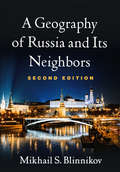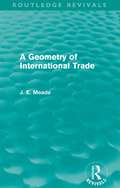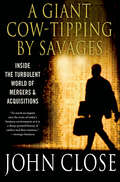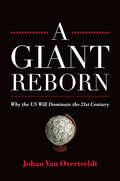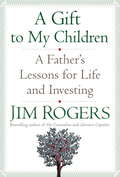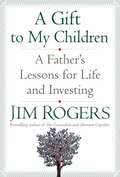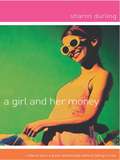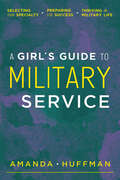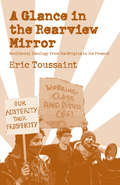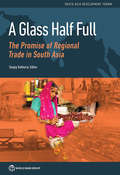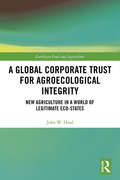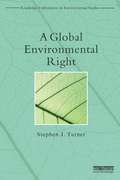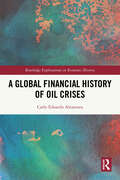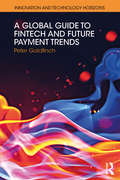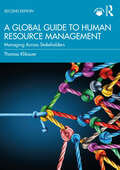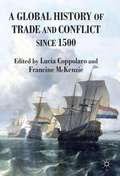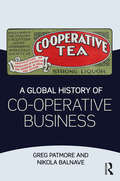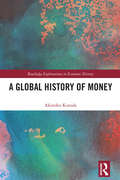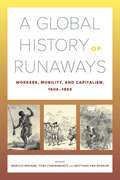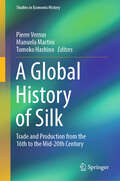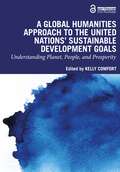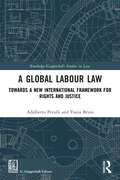- Table View
- List View
A Geography of Russia and Its Neighbors, Second Edition
by Mikhail S. BlinnikovAuthoritative yet accessible, the definitive undergraduate text on Russian geography and culture has now been thoroughly revised with the latest data and hot topics, such as the political crisis in Ukraine and the annexation of Crimea and Sevastopol. Thematic chapters provide up-to-date coverage of Russia's physical, political, cultural, and economic geography. Regional chapters focus on the country's major regions and the other 14 former Soviet republics. Written in a lucid, conversational style by a Russian-born international expert, the concise chapters interweave vivid descriptions of urban and rural landscapes, examinations of Soviet and post-Soviet life, deep knowledge of environmental and conservation issues, geopolitical insights, engaging anecdotes, and rigorous empirical data. Over 200 original maps, photographs, and other figures are also available as PowerPoint slides at the companion website, many in color. New to This Edition *Separate chapter on Ukraine and Crimea. *Timely topics--the political crisis in Ukraine and annexation of Crimea and Sevastopol; the return of Putin as president; climate change and environmental degradation; economic slowdown; political shifts in the republics; the role of Russian-backed forces in Syria, Libya, and Central African Republic; changes in Russia–United States relations; and more. *Thoroughly updated population, economic, and political data. *80 new or updated figures, tables, and maps. Pedagogical Features *End-of-chapter review questions, suggested assignments, and in-class exercises. *Within-chapter vignettes about Russian places, culture, and history. *End-of-chapter Internet resources and suggestions for further reading. *Companion website with all figures and maps from the book, many in full color.
A Geometry of International Trade (Collected Works of James Meade)
by James E. MeadeFirst published in 1952, this work is a systematic exposition of Professor Meade’s geometric method, bringing together into a single coherent account the modern geometrical analysis of the theory of international trade. The work makes a number of original contributions, notably in the geometrical treatment of domestic production, of the balance of payments, and of import and export duties.
A Giant Cow-Tipping by Savages: Inside the Turbulent World of Mergers & Acquisitions
by John CloseModern mergers and acquisitions, or M&A as it's more commonly known, is a new phenomenon. The buying and selling, the breaking up and combining of companies-the essence of M&A-has been a part of commerce throughout history, but only in our era has M&A itself become a business. In 2007, before the recession hit, it was a $4.4 trillion global enterprise. And yet, it remains largely unexplored. Discrete stories have been pulled from the annals of M&A, both true and fictionalized, that have become touchstones for wealth and excess. Who can forget Gordon Gekko and his "Greed is Good" speech? But while there have been a few iconic characters and tales to emerge, no one has told the rich history of M&A, until now. This is a look into that world and the people who created it. This reads like Dallas meets Wall Street, told through an intriguing narrative that not only brings to light in gritty detail all of the back room drama of such powerful players as Carl Icahn and Ronald Perelman, Marty Lipton and Joe Flom, Jimmy Goldsmith and Sumner Redstone, but also reveals how the new generation, including activist whirlwind Bill Ackman and iconoclastic new Delaware judge Leo Strine, will dominate the next tsunamic, and imminent, M&A boom.
A Giant Reborn
by Johan Van OvertveldtThe world is in turmoil. Whether one looks at Europe, Asia, North America, the Middle East, Africa, or Latin America, uncertainty and upheaval seem to be the order of the day. Nevertheless, there seems to be an odd certainty in the minds of many pundits, writers, and citizens in this highly volatile world of geopolitics: the days of the United States as the world's sole superpower are over. The consensus tells us that the United States will not be able to keep a status as a major power among China, the European community, and a resurgent Russia. How realistic is this perspective, though? Is the "air of inevitability" concerning America's demise merely a passing breeze? How solid is the "unstoppable rise" of the Chinese? How likely is it for Europe to right its ship? A Giant Reborn, from critically acclaimed author and leading economic journalist Johan Van Overtveldt, dispels many of these ingrained assumptions and argues that the 21st century will be defined by the country currently best set up to succeed: the United States of America. In the current chaotic political climate it seems risky to say any country will be able to maintain its current status. But Van Overtveldt provides a measured, insightful, and thoroughly engaging examination of the evidence. In his richly detailed style and straightforward explanations, he masterfully lays out a case for why America, against many pundits' best predictions, is set up to continue its 20th-century success into this millennium. A Giant Reborn shows readers that the reports of America's death, to paraphrase the father of American literature, have been greatly exaggerated.
A Gift to My Children
by Jim RogersWhen I was a boy, my father often pulled me aside to convey lessons intended to build what we generally refer to as "character". Often his advice was very simple - work hard, think for yourself, do right by others - but I believe those lessons provided the foundation for everything that has followed in my life. Now that I'm a dad myself, I wanted to put them down in one place, with examples of my own experiences, as a guide to life, adventure, and investing, both for my young daughters and for anyone seeking success in his or her chosen field. I hope that parents will be inspired to give this book to their children, and vice versa, as many of the lessons that I have learned apply not just to young people but to all adults-for example, question everything, never follow the crowd, and beware of boys!-A Gift to My Children
A Gift to My Children: A Father's Lessons for Life and Investing
by Jim RogersA Gift to My Children is a commonsense guide to personal finance. In practical advice books, as in life, there are no guarantees, and readers are cautioned to rely on their own judgment about their individual circumstances and to act accordingly.
A Gift to my Children
by Jim RogersWhen I was a boy, my father often pulled me aside to convey lessons intended to build what we generally refer to as "character". Often his advice was very simple -- work hard, think for yourself, do right by others -- but I believe those lessons provided the foundation for everything that has followed in my life. Now that I'm a dad myself, I wanted to put them down in one place, with examples of my own experiences, as a guide to life, adventure, and investing, both for my young daughters and for anyone seeking success in his or her chosen field. I hope that parents will be inspired to give this book to their children, and vice versa, as many of the lessons that I have learned apply not just to young people but to all adults--for example, question everything, never follow the crowd, and beware of boys!What a lovely, lovely book! Though I've read all you've written, this one really touched me. It is, of course, a love letter to your daughters, which is not only a wonderful, meaningful thing to do, but it was filled with exactly the kind of advice all fathers should give. Your new book will stay on my shelf for a long, long time, and I'll be giving it to my own kids to read.--Nicholas Sparks, author of The Notebook, Dear John, and The Last Song
A Girl Called Jack: 100 delicious budget recipes
by Jack Monroe100 simple, budge and basic-ingredient recipes from the bestselling and award-winning food writer and anti-poverty campaigner behind TIN CAN COOK 'A terrific resource for anyone trying to cook nutritious and tasty food on a tight budget' Sunday Times______ Learn how to utilise cupboard staples and fresh ingredients in this accessible collection of low-budget, delicious family recipes. When Jack found themselves with a shopping budget of just £10 a week to feed themselves and their young son, they addressed the situation with immense resourcefulness and creativity by embracing their local supermarket's 'basics' range.They created recipe after recipe of delicious, simple and upbeat meals that were outrageously cheap, including: · Vegetable Masala Curry for 30p a portion · Jam Sponge reminiscent of school days for 23p a portion · Onion Pasta with Parsley and Red Wine - an easy way to get some veg in you · Carrot, Cumin and Kidney Bean Soup - tasty protein-packed goodness In A Girl Called Jack, learn how to save money on your weekly shop whilst being less wasteful and creating inexpensive, tasty food.______ Praise for Jack Monroe: 'Jack's recipes have come like a breath of fresh air in the cookery world' NIGEL SLATER 'A terrific resource for anyone trying to cook nutritious and tasty food on a tight budget' Sunday Times 'A plain-speaking, practical austerity cooking guide - healthy, tasty and varied' Guardian 'A powerful new voice in British food' Observer 'Packed with inexpensive, delicious ideas to feed a family for less' Woman and Home
A Girl and Her Money
by Sharon DurlingFrom managing her own finances as a single woman to transacting billions for her clients as a bond broker, author Sharon Durling knows money--what to do with it and how to multiply it. Better yet, she shares the 411 so we can easily understand it and get control of our pocket books and bank accounts.Engagingly written and highly interactive, A Girl and Her Money will change the way women everywhere think and feel about money. Never has money-talk been so enjoyable and empowering!Topics include:Identifying Your Spending PersonalityChoosing a Money LifestyleChemo for Chronic Bad Debt"If Men Are from Home Depot, Women Are from Macy's"Coming Soon:A Girl and Her Brilliant InvestmentsA Girl and Her Luminous RetirementA Girl and Her Fabulous Home Business
A Girl's Guide to Military Service: Selecting Your Specialty, Preparing for Success, Thriving in Military Life
by Amanda HuffmanFor any young woman considering a job or career in the military.With information, tips, and perspective gathered from a variety of women who serve, this introductory guide will help you:Discern if military service is the right choice for youEvaluate enlisting or commissioning as an officerSelect a service branch and career fieldPrepare for training, mentally and physicallyIntegrate personal life, relationships, and motherhood with military serviceManage stress and increasing mental toughnessNavigate unique challenges as a woman in the military Thrive in your military career!Applicable for enlisted and officer careers in any US Armed Forces service branch and type of service commitment, including:Air Force, Army, Coast Guard, Marines, Navy, Space ForceActive duty, National Guard, Reserves"... a solid, factual, and practical guide to help young women make a major life decision with confidence ... Strongly recommended."—Mari K Eder, Major General, US Army (Ret)"... a perfect guide to help any woman considering life in uniform get straight talk on how it all works ..."—Jose Velazquez, Sergeant Major, US Army Public Affairs (Ret)
A Glance in the Rear View Mirror
by Eric ToussaintAs the financial crisis continues to shake the economy it has begun to expose cracks in the ideology long used to justify neoliberal policies. This informed and accessible primer drives a wedge into these cracks, allowing the non-expert to understand the flaws in the economic philosophy of the 1%.
A Glass Half Full: The Promise of Regional Trade in South Asia (South Asia Development Forum)
by Sanjay KathuriaTrade has played a critical role in global poverty reduction. In harnessing the potential of trade, some of the most successful countries have developed strong trade relationships with their neighbors. However, many South Asian countries have trade regimes that often offset the positive impact of geography and proximity. This report documents systematically the gaps between current and potential trade in South Asia and addresses important specific barriers that have held trade back. These barriers include tariffs and paratariffs, real and perceived nontariff barriers, connectivity costs, and the broader trust deficit. This policy-focused report unpacks these critical barriers to effective trade integration in South Asia through four in-depth studies that produce new, detailed, on-the-ground knowledge. Three of the studies are based on extensive stakeholder consultations. Two also rely on tailored surveys. The fourth study, on tariffs, benefits from new data on paratariffs. The report also marshals new evidence showing how trading regimes in South Asia discriminate against each other. Given the South Asian context, incremental, yet concrete steps aimed at tapping the potential of deeper integration are appropriate. The report has been drafted in this spirit. It offers precise, actionable policy recommendations that could help achieve measurable progress in key areas of trade and integration that would be to the advantage of all countries in the region.
A Global Corporate Trust for Agroecological Integrity: New Agriculture in a World of Legitimate Eco-states (Earthscan Food and Agriculture)
by John W. HeadThis book examines global environmental governance and how legal, institutional, and conceptual reform can facilitate a transformation to a new ‘natural-systems’ form of agriculture. Profound global climate disruption makes it essential that we replace our current agricultural system – described in this book as a fossil-carbon-dependent ‘modern extractive agriculture’ – with a natural-systems agriculture featuring perennial grains growing in polycultures, thereby mimicking the natural grassland and forest ecosystems that modern extractive agriculture has largely destroyed. After examining relevant international legal and conceptual foundations (sovereignty, federalism, global governance) and existing international organizations focusing on agriculture, the book explores legal and institutional opportunities to facilitate dramatic agricultural reform and ecological restoration. Among other things, it explains how innovative federalism structures around the world provide patterns for reorienting global environmental governance, including what the book calls eco-states that would, through exercise of pluralistic sovereignty, be responsible for agroecological management. Drawing from his experience working in international institutions, the author provides detailed global-governance proposals for facilitating the type of agricultural reform that can help avoid ecological collapse, especially through soil degradation and climate change. This book will be of great interest to students and scholars of international law, agroecology, climate change, ecological restoration, sustainable development, and global governance, as well as policy-makers and practitioners working in these fields.
A Global Corporation: A History of the International Development of Massey-Ferguson Limited
by Edward Neufeld<p>The international or multi-national corporation has become an important phenomenon in today's business world and Massey-Ferguson is an ideal example of such an organization. Through its predecessor companies it can train its history to 1847, and so it has encountered virtually all the difficulties and developments of the last hundred years in business organization and management science. The development has not been straightforward for it has been much more than the growth of a single company in an expanding market. Management reorganization and the introduction of new management planning and control teachniques contributed a good deal to the company's expansion, and because mergers played a vital role, the history of other companies is also involved. <p>Dr. Neufeld's study concentrates on the years after the Second World War, a period in which the company's international operations became increasingly complex. He records the events that helped to shape the company's character and structure, and at the same time investigates the company's successes and failures in adjusting to a changing national and international business environment. His study reveals why Massey-Ferguson developed into a global corporation, an organization that considers the whole of the international environment when making decisions relating to the allocation of its marketing, purchasing, manufacturing and engineering activities.</p>
A Global Environmental Right (Routledge Explorations in Environmental Studies)
by Stephen TurnerThe development of an international substantive environmental right on a global level has long been a contested issue. To a limited extent environmental rights have developed in a fragmented way through different legal regimes. This book examines the potential for the development of a global environmental right that would create legal duties for all types of decision-makers and provide the bedrock for a new system of international environmental governance. Taking a problem solving approach, the book seeks to demonstrate how straightforward and logical changes to the existing global legal architecture would address some of the fundamental root causes of environmental degradation. It puts forward a draft global environmental right that would integrate duties for both state and non-state actors within reformed systems of environmental governance and a rational framework for business and industry to adhere to in order that those systems could be made operational. It also examines the failures of the existing international climate change regime and explains how the draft global environmental right could remedy existing deficits. This innovative and interdisciplinary book will be of great interest to policy-makers, students and researchers in international environmental law, climate change, environmental politics and global environmental governance as well as those studying the WTO, international trade law, human rights law, constitutional law and corporate law.
A Global Financial History of Oil Crises (Routledge Explorations in Economic History)
by Carlo Edoardo AltamuraIn this book, Altamura analyses the oil shocks of 1973 and 1979, considering their impact on the world economy and subsequent reactions to the global instability.In terms of actors, the focus is on how international organisations such as the IMF, World Bank and OECD responded to the crisis, as well as the behaviour of commercial banks and central banks and of countries in the Global South. Altamura draws on newly available archival material from private financial institutions to paint a full picture of a rapidly changing world which paved the way for stagflation and interdependency.This monograph will be illuminating reading for economic and financial historians, plus scholars looking at energy history, the Cold War in a global context, the New International Economic Order and the political economy of the 1970s.
A Global Guide to FinTech and Future Payment Trends (Innovation and Technology Horizons)
by Peter GoldfinchBeing able to make and receive payments is an essential facet of modern life. It is integral to the banking and finance systems, and it touches all global citizens. In some areas, payment systems are rapidly evolving – moving swiftly from paper payment instruments, to electronic, to real-time – but in others, underdeveloped payment systems hold back economic and social development. This book is intended to assist the reader in navigating the payments landscape. The author explores highly topical areas, such as the role of payment systems in enabling commerce to contribute to the development of emerging economies, the evolution of payment systems from paper instruments to computerization, the role of cryptocurrencies, and the slow decline of plastic credit and debit cards owing to alternative forms of payment being introduced. Altogether, this book provides a comprehensive overview of the evolution of payment and offers projections for the future, encouraging readers to explore their own predictions, using the framework that the book has provided. It is vital reading for technologists, marketers, executives and investors in the FinTech sector, as well as academics teaching business and technology courses.
A Global Guide to Human Resource Management: Managing Across Stakeholders
by Thomas KlikauerA Global Guide to Human Resource Management is a concise HRM introductory text offering a uniquely non-region-specific approach to people management in international business organisations. The book presents an alternative to standard managerial approaches, reflecting the perspectives of multiple stakeholders (workers, trade unions, states and governments, NGOs) to critically evaluate HRM in practice and, in so doing, enables students to make effective decisions in their own practice, wherever their careers take them. Its accessibility and concision make it well suited to short courses for non-HRM and non-business specialists. This text covers all major introductory topics for non-specialists, introducing the concept and purpose of HRM, through recruitment, people, skills, designing work, promoting health, rewarding success, and successful and ethical people management. This edition includes a new chapter on green HRM. Rich with pedagogical features, the book includes five case studies per chapter to connect theory with practice. It is also supported with a range of instructor materials including online guest lectures, general discussion questions, a glossary, an index, and online documentaries that explain how to manage people. It is essential reading for students interested in Human Resources and Personnel Management, Organisational Behaviour and Development and Workplace Culture.
A Global History Of Trade And Conflict Since 1500
by Lucia Coppolaro Francine MckenzieThis book explains the causes and consequences of the intersection of two transformative global forces - trade and conflict - since 1500. The nine historical case studies - interspersed over 500 years and spanning the globe - make a major historical contribution to the enduring debate about whether trade makes peace more likely.
A Global History of Co-operative Business
by Greg Patmore Nikola BalnaveCo-operatives provide a different approach to organizing business through their ideals of member ownership and democratic practice. Every co-operative member has an equal vote regardless of his or her own personal capital investment. The contemporary significance of co-operatives was highlighted by the United Nations declaration of 2012 as the International Year of Co-operatives. This book provides an international perspective on the development of co-operatives since the mid-nineteenth century, exploring the economic, political, and social factors that explain their varying fortunes and transformation into different forms. By looking at what co-operatives are; how they have changed; the developments as well as the persecutions of the co-operative movement; and how it is an important force in promoting development and self-sufficiency in non-industrialized areas, this book provides valuable insight not only to academics, but also to practitioners and policy makers.
A Global History of Money (Routledge Explorations in Economic History)
by Akinobu KurodaLooking from the 11th century to the 20th century, Kuroda explores how money was used and how currencies evolved in transactions within local communities and in broader trade networks. The discussion covers Asia, Europe and Africa and highlights an impressive global interconnectedness in the pre-modern era as well as the modern age. Drawing on a remarkable range of primary and secondary sources, Kuroda reveals that cash transactions were not confined to dealings between people occupying different roles in the division of labour (for example shopkeepers and farmers), rather that peasants were in fact great users of cash, even in transactions between themselves. The book presents a new categorization framework for aligning exchange transactions with money usage choices. This fascinating monograph will be of great interest to advanced students and researchers of economic history, financial history, global history and monetary studies.
A Global History of Runaways: Workers, Mobility, and Capitalism, 1600–1850 (California World History Library #28)
by Marcus Rediker, Titas Chakraborty and Matthias van RossumDuring global capitalism's long ascent from 1600–1850, workers of all kinds—slaves, indentured servants, convicts, domestic workers, soldiers, and sailors—repeatedly ran away from their masters and bosses, with profound effects. A Global History of Runaways, edited by Marcus Rediker, Titas Chakraborty, and Matthias van Rossum, compares and connects runaways in the British, Danish, Dutch, French, Mughal, Portuguese, and American empires. Together these essays show how capitalism required vast numbers of mobile workers who would build the foundations of a new economic order. At the same time, these laborers challenged that order—from the undermining of Danish colonization in the seventeenth century to the igniting of civil war in the United States in the nineteenth.
A Global History of Silk: Trade and Production from the 16th to the Mid-20th Century (Studies in Economic History)
by Tomoko Hashino Manuela Martini Pierre VernusThis book explores the global development of the production and trade of silk and related industries from a historical perspective. From the sixteenth to the twentieth century, it takes long-term movements and global dynamics into account. Covering a wide geographical area, including East-Asia, Northern and Southern Europe, and North-America, the respective contributions examine economic activities related to silk production, silk processing, trading and consumption of silk and silk fabrics, while also highlighting diverse paths of industrialization and economic development. The book is divided into three parts, the first of which features contributions on silk markets and trade, covering topics such as auction sales and Sino-European trade. The second part addresses issues of work organization, institutional developments and the gendered division of labour, discussing topics such as systems of home-based and factory production and the organization of quality control. In turn, the third part highlights technological innovations and knowledge transfer. This book appeals to scholars and students of economic history who are interested in a better understanding of the key features and patterns in the development of the silk industry and trade and, more widely, in the global economic history of the early modern and modern periods.
A Global Humanities Approach to the United Nations' Sustainable Development Goals: Understanding Planet, People, and Prosperity
by Kelly ComfortThis edited textbook explores the 17 UN SDGs through 12 works from the humanities, including films, novels, and photographic collections. It provides students with the knowledge and understanding of how the humanities engage in broader social, political, economic, and environmental dialogue, offering a global perspective that crosses national and continental borders. The book takes students through the UN SDGs from a theoretical perspective through to practical applications, first through specific global humanities examples and then through students’ own final projects and reflections. Centered around three major themes of planet, people, and prosperity, the textbook encourages students to explore and apply the Goals using a place-based, culturally rooted approach while simultaneously acknowledging and understanding their global importance. The text’s examples range from documentary and feature film to photography and literature, including Wang Jiuliang’s Plastic China, Kip Andersen and Keegan Kuhn’s Cowspiracy: The Sustainability Secret, Barbara Dombrowski’s Tropic Ice: Dialog Between Places Affected by Climate Change, and Aravind Adiga’s The White Tiger, among others. Providing diverse geographic and cultural perspectives, the works take readers to Argentina, Australia, China, Costa Rica, Ecuador, France, Greenland, Haiti, India, Japan, Peru, Rwanda, Senegal, and the United States. This broad textbook can be used by students and instructors at undergraduate and postgraduate levels from any subject background, particularly, but not exclusively, those in the humanities. With added discussion questions, research assignments, writing prompts, and creative project ideas, students will gain a nuanced understanding of the interconnectivity between social, cultural, ethical, political, economic, and environmental factors.
A Global Labour Law: Towards a New International Framework for Rights and Justice (Routledge-Giappichelli Studies in Law)
by Adalberto Perulli Vania BrinoThis book explores the prospects of a global labour law system. Global labour law is understood as a still non-coherent set ofnorms that at different levels and with different legal effectiveness regulate legal labour relations, promote respect for fundamental social rights, and condition the behavior of the multinational enterprise, from a social justice and sustainability perspective. The book deals with both international labour law and regulatory instruments of different kinds, such as social clauses in international trade treaties or corporate codes of conduct, transnational collective bargaining, and EU directives on due diligence. This complex normative “system” is partly reconstructed and partly subjected to critique, with the aim of producing a hybrid handbook in which the elements of normative knowledge are accompanied by problematic reasoning about the forms, contents and purposes of a possible global labour law. The book will be of interest to academics, researchers and policy-makers working in the areas of Labour Law, Employment Law, International Human Rights Law and Social Justice.
